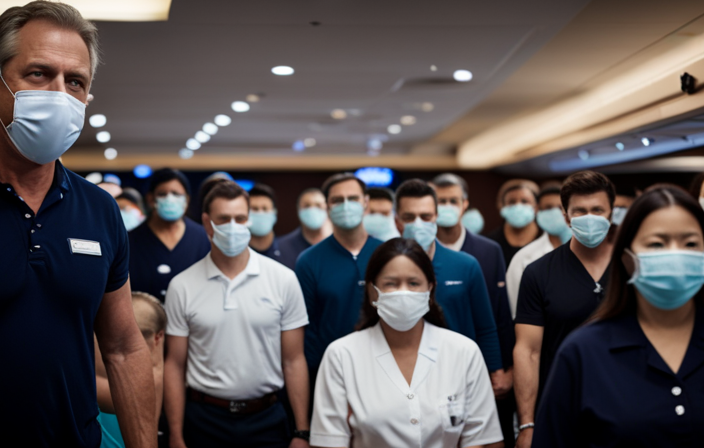The incident aboard the Diamond Princess, among the early situations in the COVID-19 pandemic, serves as an alert for densely populated areas. The CDC’s study highlights the necessity of prompt epidemiological research in these locations, encompassing cruise liners, concert halls, and healthcare facilities.
The outbreak on the Diamond Princess demonstrated how easily the virus spreads from passengers to crew members, particularly among food service workers. The crew dining area emerged as a primary source of infection, likely through food preparation and contact.
By examining this case, we can learn valuable lessons and develop preventive measures to curb future outbreaks in closed or crowded settings.
Key Takeaways
- Swift epidemiologic investigation is crucial in closed or crowded settings.
- Close monitoring of food service areas is important.
- Early detection and isolation of cases can help prevent further spread.
- Implementation of preventive measures, such as regular hand hygiene, respiratory etiquette, physical distancing, wearing masks, and following cleaning and disinfection protocols, can help prevent outbreaks in closed or crowded settings.
Lessons Learned
The Diamond Princess outbreak taught me that swift epidemiologic investigation is crucial in closed or crowded settings, and that close monitoring of food service areas is important to prevent further spread of infectious diseases.
This outbreak provided valuable lessons for prevention and transmission control in similar settings. It highlighted the need for early detection and response to identify cases and prevent further transmission.
The outbreak on the Diamond Princess demonstrated that infections can quickly spread among individuals in close proximity, especially in areas where people congregate, such as food service areas. By closely monitoring these areas, implementing regular hand hygiene and respiratory etiquette, and following cleaning and disinfection protocols, we can reduce the risk of outbreaks in closed or crowded settings.
These lessons can inform our strategies for preventing future outbreaks in similar environments.
Swift Investigation
As an investigator, I know the importance of promptly conducting epidemiologic inquiries in closed or crowded environments, such as cruise ships or music clubs, to swiftly identify and contain the spread of infectious diseases.
In the case of the Diamond Princess outbreak, a swift investigation was crucial in understanding the transmission dynamics and implementing effective prevention measures. Investigation protocols should be followed rigorously, including early detection and isolation of cases, close monitoring of food service areas, and implementation of preventive measures like regular hand hygiene and respiratory etiquette.
The transmission of COVID-19 among crew members on the Diamond Princess likely occurred through contact or droplet spread, emphasizing the need for timely investigation and intervention.
By applying the lessons learned from this outbreak, we can develop strategies to prevent and control future outbreaks in closed or crowded settings, protecting the health and safety of individuals in these environments.
Impact on Food Service
Being a food service worker on the Diamond Princess during the COVID-19 outbreak was an incredibly challenging experience. The impact of the virus on our role and the transmission through food preparation cannot be underestimated. Here are three key points to understand the situation:
-
High infection rate: Food service workers were heavily affected by the virus and played a significant role in its spread among the crew members. The close proximity in the crew dining area led to infections occurring through food preparation and contact.
-
Primary area of congregation: The crew dining area was identified as a primary source of infection. The crowded nature of this setting facilitated the transmission of the virus among the workers.
-
Lessons learned: This outbreak highlights the need for close monitoring of food service areas in closed or crowded settings. Implementing preventive measures such as regular hand hygiene, respiratory etiquette, physical distancing, and wearing masks can help reduce transmission and prevent outbreaks in similar environments.
Recommendations for Response
Implementing swift and thorough epidemiologic investigations in closed or crowded settings, such as healthcare facilities, can help identify and contain COVID-19 cases early, preventing further spread and minimizing the impact on healthcare workers and patients.
In response to the Diamond Princess outbreak, the CDC report provides valuable recommendations for outbreak response. Close monitoring of food service areas is crucial in these settings, as the infections among food service workers played a significant role in the outbreak. Early detection and isolation of cases can help prevent further spread within the facility.
Lessons from the Diamond Princess outbreak highlight the importance of preventive measures, such as regular hand hygiene, respiratory etiquette, physical distancing, and wearing masks. Additionally, rigorous cleaning and disinfection protocols should be followed to reduce transmission.
By implementing these preventive measures, outbreaks can be prevented in closed or crowded settings.
Lessons for Future Outbreaks
I have gained valuable insights from the CDC report on the COVID-19 outbreak on the Diamond Princess cruise ship, which can inform our strategies for future outbreaks. The report highlights the importance of swift epidemiologic investigation in closed or crowded settings, such as cruise ships or healthcare facilities. It emphasizes the need for early detection and response to prevent further spread. One of the key lessons learned is the significant role of food service areas in the outbreak. Close monitoring of these areas is crucial to prevent infections through food preparation and contact. To convey the importance of these lessons, I have created a table below:
| Lessons for Preparedness | Outbreak Response Strategies |
|---|---|
| Swift epidemiologic investigation | Early detection and isolation of cases |
| Close monitoring of food service areas | Preventive measures like hand hygiene and respiratory etiquette |
| Importance of early investigation | Physical distancing and wearing masks |
| Lessons from Diamond Princess outbreak | Rigorous cleaning and disinfection protocols |
| Implementation of preventive measures | Prevent outbreaks in closed or crowded settings |
By implementing these lessons and recommendations, we can improve our preparedness and response strategies for future outbreaks in closed or crowded settings.
Importance of Early Detection
Moving on from the lessons learned for future outbreaks, it is essential to discuss the importance of early detection in crowded settings.
In the case of the Diamond Princess outbreak, swift epidemiologic investigation played a crucial role in understanding the transmission dynamics of COVID-19 among crew members. This emphasizes the need for immediate action as soon as a COVID-19 case is detected in areas or groups with a large number of people.
Early detection allows for timely implementation of preventive measures, such as testing and contact tracing. These measures can help identify and isolate cases, preventing further spread of the virus. Contact tracing, in particular, plays a vital role in identifying potential sources of infection and breaking the chains of transmission.
By prioritizing early detection and prompt response, we can effectively mitigate the impact of outbreaks in closed or crowded settings.
Role of Food Service Workers
As a food service worker, it’s a juggling act trying to serve delicious meals while also unintentionally spreading the virus among my crew members.
The role of food service workers in the Diamond Princess outbreak cannot be overlooked. It was evident that infected workers played a significant role in spreading the virus to other crew members.
The crew dining area was identified as a primary area of congregation, where infections likely occurred through food preparation and contact. This highlights the importance of closely monitoring food service areas in closed or crowded settings.
Transmission through food preparation is a concerning factor and calls for strict adherence to hygiene and safety protocols. Regular hand hygiene, respiratory etiquette, and rigorous cleaning and disinfection protocols are crucial preventive measures that food service workers should follow to prevent outbreaks in crowded settings like cruise ships and healthcare facilities.
Preventive Measures in Closed Settings
Implementing regular hand hygiene, respiratory etiquette, and strict cleaning protocols is crucial in closed settings to reduce the transmission of COVID-19. Effective strategies for preventing the spread of the virus in crowded environments include physical distancing and wearing masks. These measures can help reduce the risk of respiratory droplet transmission, which is a primary mode of COVID-19 spread. Additionally, maintaining good ventilation in closed settings is important, as it can help dilute and remove viral particles from the air. The table below summarizes the preventive measures that should be implemented in closed settings:
| Preventive Measures | Description |
|---|---|
| Regular hand hygiene | Washing hands frequently with soap and water for at least 20 seconds or using hand sanitizer containing at least 60% alcohol. |
| Respiratory etiquette | Covering mouth and nose with a tissue or elbow when coughing or sneezing to prevent the spread of respiratory droplets. |
| Physical distancing | Maintaining at least 6 feet of distance from others to minimize close contact and reduce the risk of transmission. |
| Strict cleaning protocols | Regularly cleaning and disinfecting frequently touched surfaces and objects to remove any potential viral particles. |
Implementing these preventive measures can significantly reduce the risk of COVID-19 transmission in closed settings and help protect the health and safety of individuals in crowded environments.
Importance of Hand Hygiene
I can’t stress enough how crucial it is to properly clean our hands to prevent the spread of COVID-19. Hand hygiene plays a vital role in preventing transmission of the virus, especially in crowded settings.
Here are some key points to consider:
- Regular handwashing with soap and water for at least 20 seconds is highly effective in removing the virus from our hands.
- Hand sanitizers with at least 60% alcohol can be used when soap and water are not readily available.
- Avoid touching our face, especially our eyes, nose, and mouth, as these are entry points for the virus.
- Wearing personal protective equipment (PPE) such as masks and gloves is essential in crowded settings to provide an additional barrier against the virus.
By practicing good hand hygiene and utilizing appropriate PPE, we can significantly reduce the risk of transmission in crowded settings and protect ourselves and others from COVID-19.
Physical Distancing and Masks
Moving on from the importance of hand hygiene, let’s now delve into the significance of physical distancing and wearing masks in preventing the spread of COVID-19 in crowded settings.
These preventive measures play a crucial role in reducing transmission and protecting individuals from contracting the virus. Studies have shown that maintaining a safe distance of at least six feet from others can significantly lower the risk of infection. This is because respiratory droplets, which are the main mode of transmission, tend to travel shorter distances.
Additionally, wearing masks can act as a barrier, preventing the release and inhalation of respiratory droplets. It is important to note that masks should be worn correctly, covering both the nose and mouth, and should be combined with other preventive measures like regular hand hygiene and respiratory etiquette.
By implementing these measures effectively, we can help curb the spread of COVID-19 in closed or crowded settings.
Cleaning and Disinfection Protocols
Cleaning and disinfection protocols play a vital role in preventing the spread of COVID-19 in closed or crowded settings. It is crucial to adhere to specific cleaning protocols and disinfection guidelines to ensure the safety of individuals in these environments. The CDC emphasizes the importance of rigorous cleaning and disinfection practices in their recommendations for outbreak response. Regular cleaning with soap and water followed by disinfection with an EPA-approved disinfectant can help eliminate the virus from surfaces. High-touch surfaces such as doorknobs, light switches, and countertops should be cleaned and disinfected frequently. Additionally, proper ventilation and air filtration systems should be in place to minimize the risk of airborne transmission. By implementing these preventive measures, we can effectively reduce the spread of COVID-19 and protect the health and well-being of individuals in closed or crowded settings.
| Cleaning Protocols | Disinfection Guidelines |
|---|---|
| Regular cleaning with soap and water | Use EPA-approved disinfectants |
| Clean high-touch surfaces frequently | Follow manufacturer’s instructions for disinfectants |
| Ensure proper ventilation and air filtration | Allow sufficient contact time for disinfectants |
| Use disposable cleaning supplies when possible | Properly dispose of used cleaning materials |
| Train staff on proper cleaning and disinfection procedures | Maintain a cleaning schedule and checklist |
Frequently Asked Questions
How many crew members were infected with COVID-19 on the Diamond Princess cruise ship?
A total of x crew members were infected with COVID-19 on the Diamond Princess cruise ship. This case study highlights the importance of implementing preventive measures in crowded settings to prevent further outbreaks among crew members.
Did the outbreak on the Diamond Princess cruise ship lead to any deaths among the crew members?
No, the outbreak on the Diamond Princess cruise ship did not lead to any deaths among the crew members. However, the impact on their mental health and well-being was significant. The role of leadership in handling the outbreak can provide valuable lessons for future responses.
What specific preventive measures were implemented on the Diamond Princess cruise ship to control the spread of COVID-19?
To control the spread of COVID-19 on the Diamond Princess cruise ship, preventive measures included regular hand hygiene and respiratory etiquette, physical distancing, wearing masks, and following rigorous cleaning and disinfection protocols. These measures helped prevent further outbreaks in closed or crowded settings.
Were there any factors that contributed to the high number of infections among food service workers on the Diamond Princess cruise ship?
Factors contributing to the high number of infections among food service workers on the Diamond Princess cruise ship were likely close contact in the crew dining area and transmission through food preparation and contact. Precautions could have included enhanced hygiene practices and physical distancing measures.
How long did it take for the epidemiologic investigation to be conducted after the detection of the first COVID-19 case on the Diamond Princess cruise ship?
It took a few days for the epidemiologic investigation to be conducted after the detection of the first COVID-19 case on the Diamond Princess cruise ship. This delay had an impact on the effectiveness of the public health response.
Are Preventive Measures for Crowded Settings Also Applicable to Cruise Ship Safety?
When considering the consequences of cruise ship sinking, it is important to review preventive measures for crowded settings. While some safety protocols may apply, cruise ship safety requires specific procedures due to the unique environment and potential risks at sea. It is crucial to address both scenarios separately to ensure passenger safety.
Conclusion
In conclusion, the lessons learned from the Diamond Princess outbreak provide valuable insights into preventing the spread of COVID-19 in crowded settings.
Swift epidemiologic investigation and close monitoring of food service areas are crucial in detecting and responding to outbreaks effectively.
Regular hand hygiene, physical distancing, wearing masks, and rigorous cleaning and disinfection protocols are essential preventive measures.
As the saying goes, ‘an ounce of prevention is worth a pound of cure.’ By implementing these measures, we can mitigate the risk of future outbreaks in closed settings and protect the health and safety of individuals in these environments.










